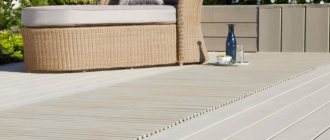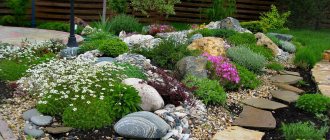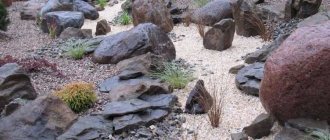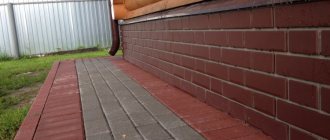The owner of a private house or cottage is trying to develop the surrounding area. And at the same time, it is important to make the site not only aesthetic, but also practical. Therefore, considerable attention is paid to garden paths. Fortunately, there are different options for garden paths. They differ in cost and production time, service life, appearance and complexity of the device. What can paths in the garden be made from? From almost everything. And we will briefly talk about the most interesting solutions in the article.
Path made of pallets in the garden
Are you planning to arrange wide paths in your dacha? And at the same time, do you have the opportunity to buy old pallets inexpensively? Then there is a great way to quickly and easily do the job yourself without spending extra money.
Of course, it won’t be possible without preparation – no one has canceled the marking and excavation work. But before laying the sand and gravel base, you will have to cover the bottom with geotextiles or roofing felt. They protect wooden pallets from moisture and prevent grass from growing on the path.
The pallets themselves also need to be prepared. First of all, look for damaged slats (if old pallets are used) - they need to be replaced. It might even make sense to disassemble one and use it as spare parts for the rest. In addition, do not forget to treat the entire surface with an antiseptic, and it is advisable to cover the lower bars with mastic - this will significantly extend the life of the track.
The rest of the installation is simple. The main thing is to ensure that the pallets are the same height and that there are no differences between them.
Along the edges of the future path around the dacha, logs with a section of 100x100 mm or 100x150 mm are laid. Pallets are placed on them, which are fixed using self-tapping screws. Thus, the pallets form a single path and will not move under load. As you can see, making them yourself is not difficult.
Video
Ideas
pallet track 1
pallet track 2
pallet track 3
Wooden garden paths
A wooden garden path is a universal solution, as it matches the lawn and garden beds, and is also environmentally friendly and easy to install. The cost depends on the type of wood chosen; the most economical option would be to use boards left over from construction work.
Wooden garden paths come in two types: laid and dug in. Larch is considered the best material for them, but oak, aspen and conifers are also suitable.
Layered wooden paths
In this case, the wooden canvas will be located above the ground, forming a kind of wooden sidewalk. Thanks to this, the tree will be ventilated and will last longer.
Photo: Instagram thermodecking
The basis for such a path are logs - rectangular bars made of building grades of wood. The logs will be in the ground, so before use they are covered with protective materials, such as mastic.
In the place where the path will pass, a layer of earth of 20-30 cm is removed, and the bottom is compacted. The length and shape of the future path is selected based on the wishes of the owner of the site, and it is better to make the width at least 80-100 cm, for free and comfortable movement along it. Then wet sand is poured onto the ground and compacted. A thin layer of fine crushed stone is laid on top of it. Such preparation will make the path more durable, as it will remove moisture.
Photo: Instagram thermodecking
- Landscape
How to make a path from wood cuts with your own hands
Boards 2.5-5 cm thick are used as flooring. The reverse side is also treated with mastic. Then the flooring is attached to the joists using self-tapping screws and nails. It is important to ensure that their caps do not stick out of the tree and injure anyone.
Photo: Instagram leskhimprom
- Country cottage area
8 common and serious mistakes in laying paths on the site (to know and not to repeat!)
Dug-in wooden walkways
Both boards and log cuts are suitable for such paths. The path material will be in the ground level with the ground or slightly protruding.
Since the tree will be in contact with the ground, it must be prepared first. To do this, the material is soaked in an antiseptic solution and then covered with bitumen. The upper part of the flooring is covered with varnish or wax.
Photo: Instagram drova_ugol_briket_msk
Photo: Instagram drova_ugol_briket_msk
Photo: Instagram gorodu_net
For such paths, the same thorough soil preparation will be required as for laid ones in order to remove excess moisture.
- Landscape
5 budget materials for the local area in the country that you can lay yourself
Tire track
However, it is not necessary to wait until the tires are recycled and you will have to pay a lot of money for the rubber track made from them. Some craftsmen make paths near their dachas from tires! You can get them at service stations and tire companies, and completely free of charge - the employees will even be grateful if you save them from unnecessary junk.
True, you will have to work hard with tires. First of all, they need to be cut into strips. If you plan to do this yourself, you need to know that you should cut along the edge - then the rubber will easily straighten and be even. After this, the tire is cut into strips of the required width. When enough material has been prepared, installation can begin. Of course, to do this you need to dig a place for the future path and arrange a cushion of sand and crushed stone. And on very heaving soils, you can also organize a cement screed. On normal soils you can do without it.
Now the tire belts themselves are leveled. To do this, they are nailed to slats or boards impregnated with an antiseptic or coated with waterproof mastic. Already in this position, a path is laid out of them. It is important to ensure that there are small gaps between the strips through which water can easily drain from the path, allowing it to dry quickly after rain.
Video
Ideas
garden path made of tires 2
garden path made of tires 3
garden path made of tires 4
Stone garden paths
Garden paths made of stone are more durable than wood and also fit well into the garden landscape.
Garden path made of natural stones
Natural stone is a very durable material, and it will not only fit harmoniously into the landscape, but also serve for a long time. It is suitable for those who often transport heavy cars around their summer cottage.
Wheelbarrow BELAMOS 4562Р
The stone can be laid on sand (and cement the gaps) or cement-sand mortar.
Photo: Instagram ambito_happyfarm
Photo: Instagram ambito_happyfarm
Photo: Instagram ambito_happyfarm
The paths look very nice where fertile soil has been laid between the stones and seeds for the lawn have been planted.
Photo: Instagram dacha_blog
Gravel garden path
The easiest way is to make a gravel walkway. To do this, preliminary preparation of the site is carried out: stumps, bushes and stones are removed. Then the outline of the future path is outlined and a layer of soil 20-25 cm deep is removed. The edges of the pit are leveled, and a layer of coarse crushed stone 5 cm thick is laid on the bottom. Wooden boards treated with bitumen are laid on top of this layer. Every meter along the edges of the path, spacers are inserted - bars that allow you to navigate without a tape measure. The last step is to lay down a layer of gravel.
Photo: Instagram construction_company_garmoniya
Photo: Instagram construction_company_garmoniya
Photo: Instagram gorodu_net
- Cleaning
Cleaning outdoor terraces and paths made of different materials: 7 useful tips
Pebble garden path
A patterned pebble path looks very creative. It is quite simple to create, but requires some painstaking effort. To begin with, pebbles that match the intended pattern are collected and selected. They are usually easy to find near rivers and lakes.
Photo: Instagram ambito_happyfarm
Photo: Instagram barhan_minsk
Photo: Instagram dizozelenenie
Then a mixture of cement, sand and gravel chips is laid out on the trench dug for the path. Pebbles are fixed in it, as in this photo. To consolidate the result, it is better not to walk on the path for several days so that it has time to harden.
Photo: Instagram hand.made.rus
Path at the dacha made of bottles
If we talk about budget paths at the dacha with your own hands, then it’s worth mentioning the option made from bottles. These can be plastic or glass bottles; some craftsmen lay out paths from plastic corks! Such paths are not afraid of temperature changes and high humidity, are durable and easy to use.
The bottles are pre-washed, cleared of labels and filled with water, sand or soil so that they do not deform under load. By the way, this is a great opportunity to get rid of the soil that appeared as a result of digging a trench - often there is nowhere to put it.
First, a trench is dug - the depth is about 30-40 cm. The bottom needs to be compacted and formwork built on the sides. Gravel, crushed stone or broken brick is laid at the bottom. Then there is a layer of geotextile or roofing felt - so that the grass does not grow and spoil the appearance of the path. A cushion of crushed stone and sand is poured on top of it. Bottles can be installed either vertically (neck down) or horizontally (neck towards the edge of the path). They are adjusted as closely as possible to each other. The gaps are filled with a mixture of dry cement and sand, and then watered with water from a watering can. Once the concrete has cured, you will have a strong, durable, cheap and attractive garden path.
Video
Ideas
Country house path made of bottles 1
Country house path made of bottles 2
Country house path made of bottles 3
garden path at the dacha made of bottles 4
How to choose sand for paths
There are different types of sand on sale, each with different properties.
If you want to choose a material for paths, pay attention to the following characteristics:
- View
- Faction
- Grain composition
- Filtration coefficient
- Radioactivity
In the next part of the text we will briefly describe the significance of each property of sand when arranging garden paths.
View
Sand is divided into types according to the following principles:
- By origin (natural, artificial)
- By mining method (river, alluvial, quarry, effigy)
- By processing method (seeded, washed, enriched)
For paths it is better to take natural sand. It is formed by natural weathering of rock, lies at the bottom of reservoirs, in the upper layers of the soil, next to other rocks.
Artificial sand is formed by crushing stone, and is actually screening. You can read about it in the article Screening for tracks.
Particular attention should be paid to quartz sand. It is obtained by processing mountain quartz. This material has a beautiful appearance, so it is well suited for decorating the top covering or filling the seams between tiles.
As for the extraction method, here you can purchase sand of any type. It all depends on what purpose you are going to use it for.
Here are some recommendations:
- For foundations, it is better to take river or alluvial sand, as it allows water to pass through better.
- The top layer of a temporary path or passage between the beds can be covered with either river or quarry sand. Before backfilling, you should check to see if there is a large amount of clay in it, which will begin to get wet in the rain. For the top layer, we do not recommend using epoxy sand, as it may contain harmful impurities (mercury, cyanide).
The processing method largely affects the cost of the material. The most expensive is enriched sand. It is used for critical construction work. There is no point in buying it for a garden path. Therefore, you can take the seeded material - its quality fully meets the requirements.
Fraction
There are many fractions of sand, depending on the size of the grains.
We will talk about three main sizes:
- Coarse-grained
- Medium grain
- Fine-grained
When arranging a path, you can use several varieties. For example, coarse sand is best for the bottom layer of the path. It allows water to pass through well and will act as a drainage system. To lay tiles, you can use medium-grained or fine-grained varieties, as they compact better. But for covering it is better to use coarse or very coarse sand, since fine sand is easily blown by the wind.
Grain composition
The grain composition takes into account the presence of dust and clay particles, silt and lumps of clay in the sand. There are no special requirements for the material used for the paths. If you just want to make markings, you can use inexpensive material with a lot of impurities.
For the base, sand that meets GOST standards is better suited. It should contain no more than 5% impurities. But for the layer under the tiles, some craftsmen even advise using sand with clay particles. It compacts more tightly. True, when moistened, clay often swells and swells in winter. Over time, this can cause the track to warp.
Filtration coefficient
The indicator is very important if you are going to lay a path in a wetland. The sand cushion or covering in this case will act as drainage. The filtration coefficient of the material ranges from 0.5 to 20 m/day. It is greater in the coarse-grained fraction, and decreases with a high content of dust or clay. For quarry sand, the indicator ranges from 0.5 to 7 m, and for river sand – from 5 to 20 m.
To prevent your path from turning into a swamp, take sand with a rate of at least 5 m/day. This is true for both the pillow and the top cover. The only case when you can ignore the filtration coefficient is the choice of sand for marking. It is also of little value when filling temporary passages between beds or on construction sites.
Radioactivity
Garden paths are always laid in a residential area. Therefore, the level of radioactivity of the material is important. It may be overestimated for quarry sand, which is mined next to rocks, such as granite. Ideally, the numbers should not be more than 370 Bq/kg. The radioactivity in the material that we have on sale is several times lower.
Temporary path on a summer cottage
Temporary tracks cannot be a full replacement for permanent pavement. But while there is nothing else, with their help it is possible to ensure normal movement around your garden and garden property. Beds, flower beds and lawns are not damaged by the soles of heavy shoes and the wheels of garden wheelbarrows. If you put in a little more effort, the temporary paths will not only look neat, but will also become a decoration for the site.
Geogrid path
You can also buy special cellular panels to strengthen soil surfaces. The installation process consists of the following steps:
- The geogrid is laid out in the required directions.
- They are fastened with pins along the outer cells.
- The void structure is filled with sand or gravel.
- If desired, you can fill the cells with fertile soil and then sow them with lawn grass. The ribs of the mesh grid will prevent the green lawn from being trampled.
The polymer material has sufficient strength and is not subject to rotting. Therefore, temporary installation can later become a permanent object of dacha landscaping.











